Little Dragon: "We’ve done this playing and composing thing for a long time, so I’d be surprised if we didn’t get any better at it."
With the release of their sixth album New Me, Same Us, Little Dragon find themselves at the peak of their powers
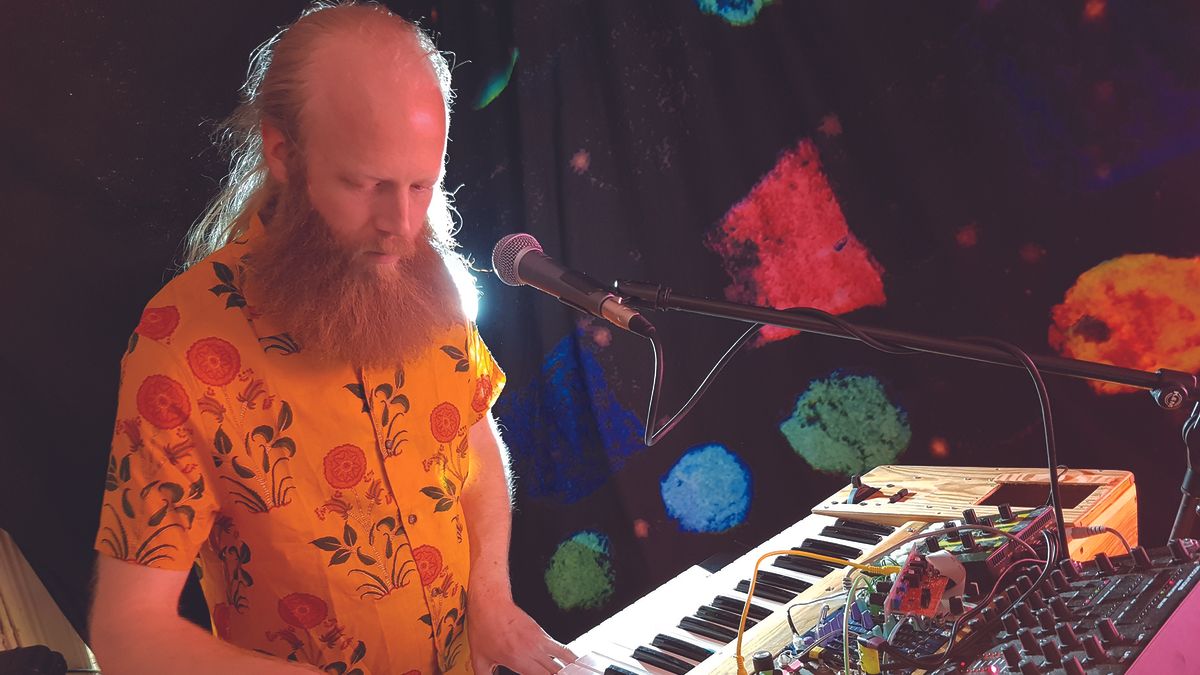
Formed during high school in Gothenburg, Sweden in 1996, indie-electronic group Little Dragon immediately garnered attention for their sombre yet exquisite ballad Twice.
The collective, comprising Yukimi Nagano, Erik Bodin, Fredrik Wallin and Håkan Wirenstran, signed to Peacefrog Records for their eponymous debut album, lighting the blue touch paper on what would turn out to be an illustrious career underscored by critical acclaim.
The title of their latest album, New Me, Same Us, signifies Little Dragon’s ability to regenerate. Their joint capacity to improve themselves as musicians has been an ongoing process that now sees them more comfortable in their own skin than ever before, further emphasised by their decision to self-produce the album at their homemade Gothenburg-based studio.
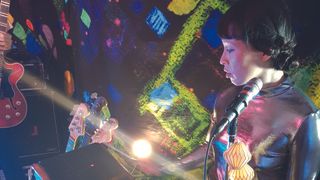
Yukimi, what’s the story behind the band being named after you?
Yukimi: “Back in the day we used to have lots of passionate explosions - I spat fire once or twice and was nicknamed Little Dragon. We’re four people with lots of opinions. On some rare occasions we agree, but most of the time we disagree. It’s a beautiful thing to find solutions and new ways to communicate our differences, but I think it’s inevitable for any band to have friction.”
Frederik: “We’re not cloned quadruplets or a creepy cult; we’re four very different individuals who make up this beautiful, somehow democratic band. Most of the time we’re civilised, but there are moods, pouts and the occasional object thrown.
"Remember, we’re dealing with serious, complex decisions concerning the rhythm and sound of a song or visual element, so things are bound to get rough. But we always manage to agree, or agree to disagree, in the end, and that’s something we’ve become much better at lately. As Yukimi says, it’s the friction that makes us spark.”
Get the MusicRadar Newsletter
Want all the hottest music and gear news, reviews, deals, features and more, direct to your inbox? Sign up here.
While being together for so long gives you the benefit of familiarity, does it also become difficult to change things up over time?
Yukimi: “It’s easy to fall into patterns for sure, but I think that challenge goes for any artist. Whether you’re a solo artist or in a group, the question of how to challenge yourself and your sound when you’re starting to get comfortable always tends to pop up at some stage.”
We’re not cloned quadruplets or a creepy cult; we’re four very different individuals who make up this beautiful, somehow democratic band.
Frederik: “We make an effort not to repeat ourselves and have always been open to exploring new ways of writing and playing. We’ve embraced our minimalistic approach and sound and become more confident in our uniqueness, but also more open to new sounds and grooves. More than ten years of touring together has also made us a much tighter unit.”
What themes do you find yourself writing about lyrically, particularly on your latest album New Me, Same Us?
Yukimi: “It’s been a special, transitional time in my life with lots of changes, so change has been a theme as well as reflections on relationships - sadness, joy and the whole spectra of feelings that usually revolve around any change.
"Sometimes the lyrics just fall into my lap like a nice surprise, other times I have to work endlessly and rewrite them over and over again. There is no recipe.”
How do you think the band has developed musically across the six albums you’ve released to date?
Håkan: “At the beginning we were searching for our identity and had more of an underdog mentality. The first album felt more like a bunch of demos that didn’t necessarily connect to each other much. Sometimes we were a bit pretentious and protective with the music or we’d spend months perfecting one song until we realised there’s no such thing as a perfect song.
"We’ve always heard from people that we sound much better live than on record, but I’ve never really understood if I should be happy about that or not.”
Yukimi: “Every album tells its own story; we’ve been in different places in life with every release. It’s gone left, right, up, down and inside out, but I’ve always had a deep aspiration to create, write and share music. The rest is for the world to define.”
Was there anything different about your approach when it came to recording New Me, Same Us?
Yukimi: “In a way, yes. For this album, we returned to using some acoustic instruments that we hadn’t visited since the first album. Every stage is usually a contrast to the last and it felt very collaborative and honest. In the past we were stuck more in our individual caves, but this time we all sat in the same room and reworked the demos together.”
Frederik: “We were more ruthless with the songs and demos and trusted them to stand up without a certain production or sound. We also experimented more and tried out most of the ideas that were put forward. You never know what works unless you try, so we recorded a lot of the bass, drums and keyboards live together. Some tracks live by their minimal arrangement and we took a collective decision on whether to leave it like that.”
The album sounds more soulful than previous works – less electronic perhaps. Was that the intention from the start?
Yukimi: “I think that’s the outcome of stepping away from some of the more electronic demo sounds we used to use and playing the songs from scratch with bass, drums and harp. Maybe that added a more classic, soulful element. I think we’ve gone full circle in a way, but it wasn’t deliberate.”
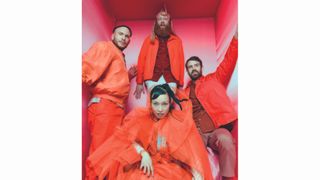
You’ve become increasingly accomplished musicians. Are you surprised at how far you’ve developed despite not having musical training?
Håkan: “Thank you for saying that. To be honest, we all have a little bit of formal musical training and we’ve done this playing and composing thing for a pretty long time, so I’d be surprised if we didn’t get any better at it. We’ve definitely grown to know each other musically over the years and that’s made our playing pretty organic. We learn from each other and by listening to all the great music out there… and the music that’s ‘out there’; it’s never too late to learn something new.”
Erik, does your role in the band go beyond being a drummer?
Erik: “I feel like I have two personalities, effectively. When I’m in the studio I’m a drummer and keyboardist and a few times I’ve sung vocals. I started off my musical journey with the piano, picked up drums a few years later and now write together with the rest of the band on most tracks. And I also produce and mix a bit here and there.
"When it comes to playing live, I’d say that I represent more of an engine – trying to do my best to help out my fellow band members when they’re playing live and being spontaneous.”
We learn from each other and by listening to all the great music out there… and the music that’s ‘out there’; it’s never too late to learn something new.
How’s your studio evolved over the years and what’s it like now? Is all the gear in one dedicated room?
Håkan: “We’ve had a great space since 2002. It’s very central to Gothenburg; quite big and very cheap. Unfortunately, that comes with a ‘but’ because we’ve always lived under the threat of it being torn down so haven’t spent much time or money making the acoustics good or filtering out all of the noise.
"Gothenburg’s most trafficked tramline runs two meters outside our window and it’s affecting the power with a constant noise that’s very rich harmonically in the 600Hz range. We actually used that noise as an intro sound for the track A New on Machine Dreams.”
Frederik: “We’ve tried to make the studio as professional as we could, while still having a homely feel to it. We each have our own room so there’s gear, gear and more gear - maybe too much in some places… no names mentioned.”
Håkan: “Fred means I have too much junk in my room, but maybe he doesn’t see the point in bringing 30 wooden organ bass pipes into the studio.
"We have three production rooms, one live room, a kitchen and a shower. Every production room is equipped with a Cubase computer, lots of synths, guitars, and a corner for recording vocals. Erik has a drum kit in his as well.”
So who’s got the most gear?
Håkan: “I’ve probably nerded out the most with equipment. There’s a semi-big 1978 MCI 428b recording desk in my room, which I’ve done a fair amount of tinkering on. I also got myself a 24-channel tape recorder from the same brand.
"Unfortunately, having done a lot of work to clean it up, when it was time to do the final tuning it blew up and there was lots of thick smoke coming out of it. I’d mixed up the different PSU cords so I’m a very sad person now, but hopefully I can restore it because the sound of that machine is unbelievable.
"The live room has a grand piano, a drum kit, a bass cabinet and a guitar amp. And, as with all the rooms, lots of useful crap!”
What guitars and pedals are you using?
Frederik: “We use an Epiphone Les Paul and a DiPInto Galaxie 2S, which mostly goes straight into the computer through a warm audio preamp. We’re mainly using Steinberg amp simulators and a few different plugins to make things sound right.”
Håkan: “We haven’t actually used that much outboard gear on this album, and I don’t know if Dillip Harris, who mixed the album, used any either. But the vocals are recorded with a Microtech Gefell M930. We compared it with some other mics at Vintage King in LA and thought that it sounded best for Yukimi.”
What’s your drum kit setup Erik?
Erik: “I’m very inspired by the ’80s reggae approach to treating drum kits. There are no resonance skins on the toms and they’re nicely damped with loads of gaffa tape and pieces of old drumheads. I also use two timbales to jam out on.
"The kick drum is heavily dampened to give it a short, fat, distinct sound. I’m quite allergic to a big fluffy, subby kick and want it to have more of a tight punch in the belly. The snare drum varies, but most of the time I’m using a brass snare with a high-tuned thin head using plenty of dampening to do the job.”
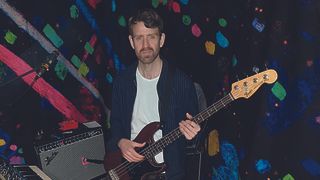
Are you supplementing your kit with the use of sampling pads?
Erik: “I quite often trigger the kick and snare through a Roland SPD-SX, which I also play electric percussion and melodies on. Brand-wise, it’s a big mixup. Yamaha for kicks and snare, which is a bit boring but reliable, some old Tama toms from the ’80s, Latin Percussion timbales, and the cymbals are usually Istanbul Agop all over. Lately, I’ve been using extra thin hats so as not to go too loud into Yukimi’s vocal mic.”
What vintage synths are the band mostly using these days?
Håkan: “We tend to use the Ensoniq ESQ-1, the Korg Lambda, Yamaha CP30, Roland D-50, Yamaha TG77 and the Oberheim Xpander a lot. I guess we like how they sound, and apart from the Oberheim they’re pretty cheap to buy.
"Using synths from different eras gives you a broader spectrum of styles and sounds to work with because there are definitely trends in sound design. That’s not a bad thing of course, but if you want to go in a slightly different direction an old, cheap, unpopular synth is great to use.
"When it comes to analogue synths it doesn’t really make sense to buy crazy-expensive collectors’ items as the new analogue synths are quite cheap and reliable. Personally, I hate synths with too many presets because I often get a headache scrolling through thousands of sounds. I call it ‘music store headache’ from hours of trying out different synths.”
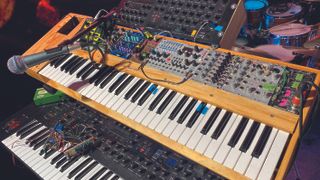
Ensoniq ESQ1
“One of the first romplers to feature 12-bit samples, but it’s far from today’s more ‘natural-sounding’ samplers. The saxophone sounds really corny and cartoonish but the kalimbas, bells and pads sound great.”
Korg Lambda
“It’s a so-called ‘string machine’ but more like an old electronic home organ with strings, choir, organ and piano sounds that you can blend together. You can also tune left and right to get a nice chorus-type effect.”
Yamaha CP-30
“Another gritty-sounding beast, which weighs about 50kg. It has harpsichord, clavinet and piano sounds that don’t sound at all like these but it always finds its ways onto our records.”
Roland D-50
“A classic from the ’80s. One of the early romplers, but totally digital with built-in effects. It uses very short samples that you blend with digital oscillators to make very digital, cold and shimmery sounds.”
Yamaha TG77
“Really good DA converters and blends sampled sounds with an updated FM synth engine. It’s highly recommended if you’re into FM synths.”
Black Corporation Kijimi
“We were thinking about how we could make our live setup sound better and the Kijimi looked flexible enough to be able to get the right sounds for our songs.”
You do have some modern synths though?
Håkan: “Of the more modern stuff, we’re using the Nord Lead A1 and the Prophet-6 because of their diversity and fatness. I also recently bought a Black Corporation Kijimi for the live setup and it sounds fantastic as long as it doesn’t go out of tune, which is something it does all the time but that’s part of its analogue charm.”
How are you using the Black Corporation Kijimi in your studio and live setup?
Håkan: “The Kijimi is the second product from the newly started synth manufacturer Black Corporation. First they built a clone of the Yamaha CS80 called Deckard’s Dream after the character in the movie Blade Runner.
"As I’m a big fan of Vangelis, I got shivers when I first heard about Deckard’s Dream because the price of an original CS80 is sky high. So I started dreaming about getting one but then the Kijimi showed up and I thought, 'hey, that’s a cool synth'. I also felt that if I got a Deckard’s Dream there was a chance of me getting too close to making fake Vangelis music.”
Are you using any other unusual instruments in the studio?
Håkan: “We used a lot of Melodyharp on this album and have a lot of crap lying around. There’s a couple of Thai gongs that were hot items when we were making our first record and I sometimes use an old Akai S620 sampler because it sounds old and lo-fi and it’s very easy to use. It’s used on the song Water for the drippy sounds.
"We also have a Yamaha VL7 virtual acoustic synth from the ’90s, which is as far from a bread and butter synth as you can get - you can hear it on the song Crystal Film. That technology is used in some of the new digital Eurorack modules, like Mutable Instruments' Elements, so it’s coming back a bit.”
Was there any particular motive that first triggered you to explore what modular could bring to your productions?
Håkan: “I’ve always done dub-style effects when we play live. In the beginning I had a small mixer and a rack reverb and delay that took up a lot of space, so when I was looking for a smaller solution I made a small Eurorack system that took up less.
"Unfortunately, as soon as I opened Pandora’s Box it was almost impossible not to get hooked on it. I’ve continued buying more and more modules and stumbled upon some pretty great stuff, especially Mutable Instruments Clouds, which gets used a lot. You can hear it on the track Every Rain.”
How has using modular changed your creative process overall?
Håkan: “For me, the modular way of making music is very chaotic and creative because I don’t know what I’m doing. In the studio, I mainly use the different oscillators and stuff in my rack like they’re monosynths that I can play on a keyboard, but I also have two different sequencers to make patterns and a few drum modules.
"As I mentioned before, I use the granular module Clouds a lot for drones or FX. I’m very drawn to the granular world and find it very interesting to put in natural sounds and make something very different and otherworldly out of them. Like in the intro to Butterflies, there is a quick sample of Yukimi humming that I smeared out as a drone in Clouds so it sounds like angels singing.”
Some artists are reticent to use modular live - are you?
Håkan: “I have one smaller Eurorack system for the live setup that consists of three preamps, a mixer, delay and reverb unit. I use it to pick signals from my synths, Yukimi’s voice or Erik’s snare and kick and then send them to the effects for ‘dub-style’ actions. It’s fun for me but annoying for our sound technician mixing the band.
"Before the mixed signal leaves my world it goes through a DJ-style hi and lo-pass filter and a compressor. I used the kick signal to sidechain the compressor on certain songs like High and Hold On, and if I go nuts with the effects, the sidechain kind of clears up my mess a bit and makes it sound more musical.
"I use the filter in a more dynamic way, almost like a volume pedal and hide myself a bit when the dynamic in the music goes down or at the end of a song when I can dive into a blur of dark reverb.”
It sounds like you’re looking to go well beyond merely replicating tracks when playing live?
Frederik: “It’s a totally different approach. Previously, we tried to replicate the studio sounds as closely as possible and used a lot of different samplers throughout the years. The Roland Fantom XR is a real beast with endless possibilities, but the downside is that it has a ten-minute start-up time. Lately, we’ve been using the Prophet X, Nord Wave and Roland SPDS pads, so we’re moving away from samples and using whatever synth or bass we enjoy playing with live.”
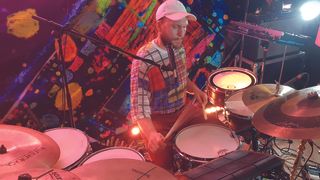
You’re using a mix of Cubase and Ableton in the studio?
Frederik: “We use Cubase as our main DAW but some sketches are made on Ableton Live. We got started on Cubase, which works and sounds great, and I started using Ableton when we got more into making dance music and remixes before discovering that it was also easy to build tracks and do sketches with it. I find that it’s extremely intuitive and playful, but Erik and Håkan are still hardcore Cubase users, so as it’s a collective process we mainly track and mix with Cubase.”
Håkan: “We don’t nerd out too much on plugins either and use a lot of what comes with Cubase 10. I tend to use the Cubase ‘distortion’ a lot because it’s great at giving you a bit of presence on a dull track. Erik often uses Steinberg’s Quadrafuzz on drums and all sorts of tracks. The different delays get used a lot, and of course the EQ and filters.
"Fred and I got ourselves a UAD card each, which is lovely. I use UAD’s Lexicon 224 and the EMT 240 reverb a lot, and the MXR flanger. The Voice of God resonance tool is another favourite of mine because it gives instant beef to a bass or kick.”
Do you work collectively when it comes to the mixing stage? And, if so, how does that process unfold for you?
Håkan: “As mentioned, Dillip Harris mixed the album in his container right out of London town. We didn’t have a lot of back and forth communication with him, just some emails and phone calls. It was a pretty frustrating way of working, especially in the beginning because we didn’t know each other that well, but by the end we were very thankful.
"We had some strong opinions at the mix stage - I felt that the mixes had got a tiny bit too clean, so I asked the mastering engineer to add a tiny bit of distortion to glue things back together.”
You’ve worked with different producers on recent albums, but not this one. Why have you returned to being self-produced?
Frederik: “We didn’t even think about it this time, it just felt natural for us to be doing it ourselves because we’re more confident in our process and different abilities.
"Our schedule for an album very much involves working Monday to Friday for a long period of time until we feel that we’ve got a good body of songs. Group dynamics can be complicated but they’re also quite comforting at times.
"When you add another person into the mix it can change the whole vibe, which could be good. But we’re very much used to working with each other at this stage, even if it can be frustrating at times when you’re trying to be democratic.”
Do you feel your role as musicians is more important to people in these difficult times?
Frederik: “We’d like to think so, but some days when you read the news it can all feel a little futile by comparison. All the love we get from our fans and the stories we hear from people about how our music has helped them through hard times is so touching and inspiring that it makes what we do feel important – not just for them, but for ourselves too.
"It’s hard to have plans during this situation though. I think we all need to stay open and adapt because we want to keep doing this for as long as possible. Maybe we’ll try out some new forms of expression and collaborations in future, or maybe we’ll just build another studio from scratch and buy an electric tour bus!"
The latest Little Dragon album New Me, Same Us is available now on Ninja Tune


Future Music is the number one magazine for today's producers. Packed with technique and technology we'll help you make great new music. All-access artist interviews, in-depth gear reviews, essential production tutorials and much more. Every marvellous monthly edition features reliable reviews of the latest and greatest hardware and software technology and techniques, unparalleled advice, in-depth interviews, sensational free samples and so much more to improve the experience and outcome of your music-making.

“I didn’t even realise it had synthesizer on it for decades”: This deep dive into The Beatles' Here Comes The Sun reveals 4 Moog Modular parts that we’d never even noticed before

Is Sabrina Carpenter the world’s biggest Teenage Engineering fan? Please, please, please say that it’s true



![Chris Hayes [left] wears a purple checked shirt and plays his 1957 Stratocaster in the studio; Michael J. Fox tears it up onstage as Marty McFly in the 1985 blockbuster Back To The Future.](https://cdn.mos.cms.futurecdn.net/nWZUSbFAwA6EqQdruLmXXh-840-80.jpg)






